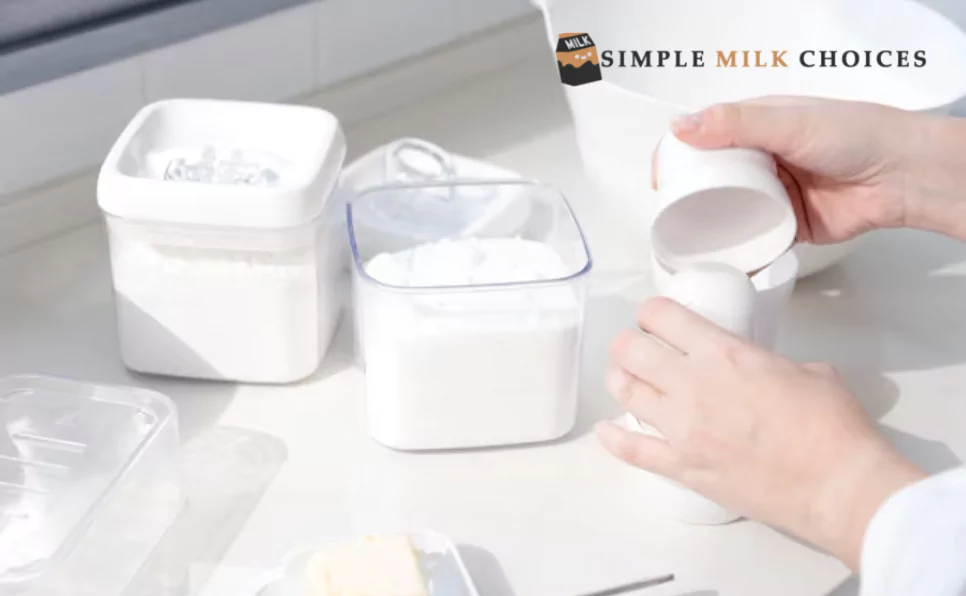Do you find yourself with too much oat milk and wondering if freezing it is a possible choice? You’re not alone! Oat milk’s popularity has soared and with good reason. It’s a creamy, dairy-free alternative packed with nutrients. But here’s the kicker: oat milk has a limited shelf life. That’s where freezing steps in as the hero, offering a way to extend its freshness. However, before you dive into freezing your surplus oat milk, understanding the significance of proper storage methods is key. Let’s embark on this journey to unravel the mysteries of freezing oat milk while ensuring its quality remains top-notch.
Imagine this: You’ve just returned from the grocery store, arms laden with your favorite oat milk brand. However, you realize it’s about to expire sooner than expected. Don’t worry! Freezing oat milk can be a lifesaver. But why is proper storage important? Well, oat milk and other dairy products are sensitive. Improper storage can lead to spoilage or a change in texture, making it taste bad. So, let’s explore the ins and outs of freezing oat milk, ensuring you enjoy every sip, whether it’s in your morning coffee or a creamy addition to your recipes.
Does Oat Milk Need to be Refrigerated?
Oat milk, the velvety dairy alternative that has taken the spotlight, possesses a hidden capability: it can flourish even in the depths of your freezer. Picture this—a relaxed morning, the scent of freshly brewed coffee wafting through the air. Just as you reach for the oat milk to complete your cup, a wave of panic hits. The carton’s label warns of an impending expiration date, threatening to disrupt your cherished morning routine. But fear not, because freezing oat milk might just be the solution you need. Can you freeze oat milk? The resounding answer is yes. Freezing works effectively. When done right, oat milk can maintain its luxurious texture and flavor for up to three months in your freezer. This information is particularly helpful for individuals exploring oat milk and breastfeeding, offering a way to extend the milk’s shelf life without compromising its quality.
Process of Freezing Oat Milk
So, how does one execute this freezing feat? It’s a simple process that involves a touch of preparation and the right containers to maintain oat milk’s integrity.
- First, ensure you have enough space in your freezer.
- Then, gather freezer-safe containers or even ice cube trays for portioning out smaller quantities.
- Pour the oat milk into these containers, leaving a bit of room for expansion, and seal them airtight to prevent freezer burn.
- Labeling the containers with the date of freezing can be a nifty trick to track their shelf life.
- Now, your oat milk is primed for its icy slumber.
The beauty of freezing oat milk lies not only in preserving its freshness but also in the diverse ways you can use it afterward. From enriching your morning brew to whipping up creamy smoothies or adding a lavish touch to your baked goods, frozen oat milk retains its versatility. Imagine those delightful ice cubes of oat milk seamlessly blending into your favorite recipes, elevating each dish with a creamy, oat-infused essence.
This freezing process is a game-changer for those who seek to avoid food waste and maximize their oat milk’s potential. Say goodbye to that sinking feeling of discovering an untouched carton extremely close to expiration. With the knowledge that freezing oat milk is not just feasible but also a boon, you can stock up without hesitation, ensuring that not a drop of this delicious mixture goes to waste.
Science of Freezing Oat Milk: Resilience and Quality Considerations
Moreover, understanding the science behind freezing oat milk enhances our appreciation for its adaptability. Due to its high water content and oat-derived starch content, oat milk freezes incredibly well. These components contribute to the milk’s creamy texture and play a pivotal role in retaining its consistency even after freezing. The freezing process suspends the milk’s molecules, preventing them from separating upon thawing. The preservation technique is a testament to oat milk’s resilience. It allows oat milk to emerge from its frozen state with minimal texture alterations.
However, a word of caution: while freezing does wonders for extending oat milk’s shelf life, the quality might slightly diminish upon thawing. This aspect becomes particularly important in commercial settings like Dunkin Donuts, where the use of oat milk in various beverages demands careful handling to ensure optimal taste and texture. It’s normal for some separation or a change in texture to occur. But fear not; a quick shake or stir post-thawing will often restore its smoothness, making it ready for consumption or culinary adventures.
Addressing Common Queries
Can you Freeze Oat Milk into Ice Cubes?
Oat milk’s versatility knows no bounds—it’s not just for a creamy coffee or a luscious smoothie. Picture this: On a scorching summer day, a refreshing iced beverage beckons. However, diluting your drink with regular ice cubes feels uninspired. Enter frozen oat milk cubes, a game-changer for elevating your chilled beverages without watering them down. But can you freeze oat milk into ice cubes? Absolutely. The process is simple and adds a touch of creamy goodness to any cold mixture. Pouring oat milk into silicone ice cube trays makes the freezing process a breeze and ensures easy removal of the cubes. However, there’s a tiny catch. Upon thawing, these frozen oat milk cubes might exhibit a slightly grainy texture, as they don’t always melt uniformly. But a quick shake or blend in your drink typically resolves this. It lets you relish your cold beverages with a creamy oat milk twist.
Accidentally Freezing Oat Milk
Oat milk, the versatile favorite of dairy alternatives, can sometimes throw a surprise curveball if left forgotten in the chilly depths of the freezer. Assume this: you’re rearranging the freezer, and there it is—a carton of oat milk tucked away and accidentally frozen. Panic sets in—is it still safe to consume? Fear not, for accidental freezing won’t render oat milk unsafe. However, get ready for a potential change in its texture and consistency. Freezing can cause oat milk to separate or develop a slightly altered texture upon thawing. But there’s a simple fix. A forceful shake or whirl in the blender can often revive its smoothness, restoring your oat milk to its former creamy glory. So, while accidental freezing might cause a temporary hiccup, it doesn’t spell the end for your beloved oat milk—it’s still perfectly safe to use and enjoy.
Why Oat Milk Doesn't Always Need Refrigeration after Opening?
Oat milk, the unsung hero of dairy alternatives, often prompts a curious query: why does it sometimes reside comfortably on pantry shelves even after opening, defying the refrigerator norm? Once more, assume that you grab a gluten-free oat milk carton. After breaking the seal, discover that there’s no need to make an urgent trip to the refrigerator. Contrary to the belief that all dairy products demand immediate refrigeration post-opening, oat milk operates under a different set of rules. Its unique composition boasts higher acidity and a lower fat content compared to traditional dairy. This composition renders it shelf-stable at room temperature for a limited time.
However, this doesn’t mean you can simply leave it out indefinitely. To extend its freshness and prevent spoilage, refrigeration after opening remains the golden rule. By chilling your opened oat milk, you’re giving it a longer lease on life, ensuring its creamy goodness stays intact for a little while longer.

Finding the Best Milk for Freezing
With so many varieties of milk available, freezing becomes the most accurate indicator of a beverage’s durability and the shelf life of almond milk. Consider this: the freezer holds thousands of possibilities; however, not all milk survives its cold sleep. Cow’s milk, the classic go-to, tends to fare decently when frozen. Its lactose content and moderate fat content contribute to a relatively stable freeze-thaw cycle.
However, navigating the world of plant-based alternatives unveils a tapestry of the freeze-ability and storage life of soy milk. Almond milk, delicate in composition, might exhibit separation upon freezing, demanding a vigorous shake to reincorporate its components. Meanwhile, soy milk proudly stands as a freezer champion, maintaining its consistency and taste even after the frosty ordeal. Then comes coconut milk, rich and indulgent, freezing admirably but occasionally showcasing textural alterations post-thawing. Consider factors such as lactose content, fat content, and the potential for separation when selecting the prime candidate for your freezing escapades. Ensure your chosen milk emerges from the freezer as a steadfast companion for your culinary adventures.
Thawing and Using Frozen Oat Milk: A Detailed Explanation
Ever found yourself staring at a frozen container of oat milk, pondering how to gracefully bring it back to its liquid state? Oat milk, with its remarkable versatility, doesn’t just freeze well; it also graciously returns to its creamy form with a bit of know-how. Picture this: you reach into the freezer, pulling out your stash of frozen oat milk, ready to embark on the thawing adventure. Fear not, for thawing frozen oat milk is a simple process, as discussed earlier, that ensures its revival in all its creamy glory. Whether opting for the refrigerator’s gradual approach, room temperature’s moderate pace, or the microwave’s expedited thawing, each method has its merits. Once thawed, a quick shake or blend can restore any potential changes in texture, ensuring your oat milk is ready for use in your favorite recipes or as a delightful addition to your morning brew.
Thawing Frozen Oat Milk: Step-by-Step Guide
Refrigerator Method
Place the frozen oat milk container in the refrigerator for gradual thawing. This method usually takes about 24 hours, allowing for a gentle return to its liquid state without compromising quality.
Room Temperature
For a quicker thaw, leave the sealed container of frozen oat milk on the countertop. Be cautious with this method, ensuring the container is well-sealed to prevent contamination and monitoring it closely to avoid temperature abuse.
Microwave Option
For those seeking swifter results, the microwave offers a convenient alternative. Transfer the frozen oat milk to a microwave-safe container. Use short bursts of low heat and stir intermittently to ensure even thawing. Exercise caution to prevent overheating or scalding the milk.
Best Practices for Using Thawed Oat Milk
After your frozen oat milk has successfully returned to its liquid form, you should shake or blend it thoroughly to homogenize any textural changes caused by freezing. This step is recommended for optimal consistency and to preserve the authentic oat milk taste. This simple step can restore its creamy consistency, ensuring a seamless transition from freezer to usage. From enriching your morning coffee to elevating your baking endeavors or creating sumptuous smoothies, thawed oat milk stands ready to embrace its role in your culinary escapades.

Potential Benefits and Concerns of Freezing Oat Milk
Did you know that freezing oat milk can be a game-changer in your kitchen, offering both convenience and versatility? Imagine this: you’re looking at the shelves, stocking up on your favorite oat milk, and suddenly, the realization hits—freezing it might just be the secret weapon to extend its shelf life and reduce waste. Yes, freezing oat milk offers a myriad of benefits, from elongating its expiration date and minimizing food waste to ensuring you always have a stash on hand for various culinary escapades. However, with these benefits, there are a few possible issues. Changes in texture can occur upon thawing, and improper storage might invite the dreaded freezer burn. But with a little care and know-how, these concerns can easily be mitigated, ensuring your frozen oat milk remains a valuable asset in your kitchen arsenal.
Let’s explore the benefits and possible risks of freezing oat milk as we go further into this topic.
Benefits of Freezing Oat Milk
Firstly, freezing oat milk is a superb strategy to stretch its shelf life beyond its initial expiration date. This simple act not only curtails unnecessary waste but also ensures you always have a backup supply ready for use. From morning coffees to decadent baking endeavors or refreshing smoothies, having frozen oat milk at your disposal allows for endless culinary creativity without worrying about running out.
Moreover, freezing oat milk can be a financial win, enabling you to buy in bulk during sales or promotions without fretting about spoilage. The cost-effective nature of this approach makes freezing oat milk a savvy choice for budget-conscious individuals seeking to maximize their resources without compromising on quality.
Concerns Associated with Freezing Oat Milk
However, freezing oat milk isn’t entirely without its concerns. Upon thawing, changes in texture might manifest—think a slight separation or a shift in consistency. But don’t worry, as a quick shake or blend can often restore its velvety smoothness, allowing you to enjoy it just as before.
Additionally, the specter of freezer burn looms if oat milk isn’t stored properly. Improperly sealed containers or prolonged exposure to freezer air can lead to this unpleasant phenomenon, altering the taste and quality of the milk. However, with vigilant attention to airtight sealing and appropriate storage containers, you can easily steer clear of freezer burn, preserving your oat milk’s integrity for future use.
Conclusion: Freezing Oat Milk for Convenience and Versatility
Consider this: your kitchen, a realm where decisions about food storage practices can make all the difference. Freezing oat milk is a revelation. It extends its shelf life beyond expectations, reduces waste, and offers countless options for culinary exploration. Freezing oat milk is versatile, offering a ready supply for various uses. It helps minimize food waste, making it a convenient solution. However, navigating the frozen landscape isn’t without its considerations. Be cautious of texture changes upon thawing. Be mindful of the risk of freezer burns. However, these challenges can be easily overcome with care and knowledge. When thinking about food storage methods, think about the versatility of oat milk. It can be frozen and revived, providing convenience without sacrificing quality. Learn about freezing oat milk. Discover its many uses in cooking and enjoy how this simple dairy alternative can be used in different ways at your table.





